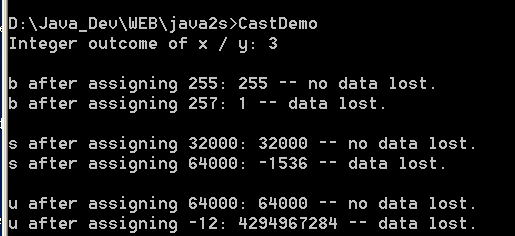Demonstrate casting

/*
C#: The Complete Reference
by Herbert Schildt
Publisher: Osborne/McGraw-Hill (March 8, 2002)
ISBN: 0072134852
*/
// Demonstrate casting.
using System;
public class CastDemo {
public static void Main() {
double x, y;
byte b;
int i;
char ch;
uint u;
short s;
long l;
x = 10.0;
y = 3.0;
// cast an int into a double
i = (int) (x / y); // cast double to int, fractional component lost
Console.WriteLine("Integer outcome of x / y: " + i);
Console.WriteLine();
// cast an int into a byte, no data lost
i = 255;
b = (byte) i;
Console.WriteLine("b after assigning 255: " + b +
" -- no data lost.");
// cast an int into a byte, data lost
i = 257;
b = (byte) i;
Console.WriteLine("b after assigning 257: " + b +
" -- data lost.");
Console.WriteLine();
// cast a uint into a short, no data lost
u = 32000;
s = (short) u;
Console.WriteLine("s after assigning 32000: " + s +
" -- no data lost.");
// cast a uint into a short, data lost
u = 64000;
s = (short) u;
Console.WriteLine("s after assigning 64000: " + s +
" -- data lost.");
Console.WriteLine();
// cast a long into a uint, no data lost
l = 64000;
u = (uint) l;
Console.WriteLine("u after assigning 64000: " + u +
" -- no data lost.");
// cast a long into a uint, data lost
l = -12;
u = (uint) l;
Console.WriteLine("u after assigning -12: " + u +
" -- data lost.");
Console.WriteLine();
// cast an int into a char
b = 88; // ASCII code for X
ch = (char) b;
Console.WriteLine("ch after assigning 88: " + ch);
}
}
Related examples in the same category